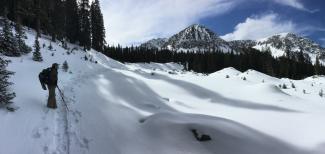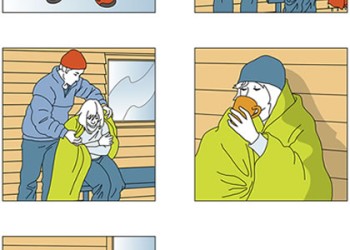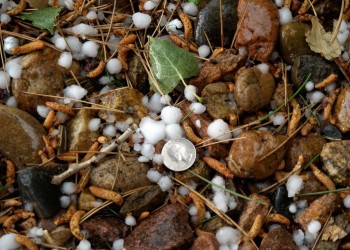Winter Conditions Safety
May 5, 2025—Late spring storms and an uptick in search and rescues this winter is causing calls for concern. Each incident is costly and dangerous to rescuers.
The Carson National Forest wants to make sure visitors are prepared for their trip and vigilant about their safety. To help you get the most of our your experience, consider these tips.
Know Your Limits

Winter hiking on the Williams Lake Trail.
Photo Credit: USDA Forest Service photo by Heath BaileyKnowing your physical and mental limits is important. If something goes wrong, could you:
- spend a cold night in the forest?
- navigate a new and unfamiliar path, possibly off-trail in the snow?
- effectively use your winter gear?
Everyone is different and each experience in the forest can show you your limits. But you must also listen to yourself and the surroundings to know when it is time to turn around, or even to know when not to go in the first place.
Understand the Conditions
Conditions can change throughout the day and over the season. Forest staff will not know specifics about your route on your trip day. It is best to understand the big picture of wintertime travel and the associated risks and prepare for specific scenarios.
Weather
Temperatures contribute to the risk of hypothermia. Check the forecast beforehand and plan accordingly based on time of day, sunset and sunrise times, high and low temperatures, wind chill and any incoming storms.
Snow and Ice Cover
You may encounter a variety of ground conditions, including snow and ice, which can cause slips and falls. The freeze and thaw cycle may change conditions between your ascent and descent. Make sure you have the proper equipment and experience to navigate.
Avalanche Danger
Check in with the Taos Avalanche Center for forecasts, conditions and more.
Have the Right Gear and Know How to Use It
It’s not only important to have the proper clothing and gear, but you must know how to use it. What’s the use of an ice axe if you have no training? The 10 Essentials is a good place to start, but you may need more, depending on your activity, the conditions and your personal needs:
- Navigation: Printed map and/or GPS device (with extra batteries)
- Sun Protection: Sun glasses, sunscreen, hat.
- Insulation: It’s best to dress in layers as conditions can change throughout your trip. Consider a waterproof shell, down jacket, hats, gloves and footwear appropriate to all conditions that you might encounter.
- Illumination: Headlamp (with extra batteries packed).
- First-Aid: Have a kit tailored for winter travel, including hand and feet warmers.
- Fire: Waterproof matches can help start a fire for heat and cooking. Make sure you’re aware of the current fire restrictions.
- Repair Kit and Tools: Duct tape, a knife and scissors can help you in a pinch.
- Nutrition: Carry an extra day’s worth of meals, especially nutrient dense foods that do not need to be cooked.
- Hydration: Have enough water to stay hydrated while traveling and any needed equipment to purify water from natural sources if you run out.
- Emergency Shelter: Tent (preferably a four season), tarp, bivy sack or emergency space blanket.
More: For winter travel, also consider an avalanche transceiver, ice axe, traction devices, and snow gaiters.
Know Before You Go
The Forest Service’s Know Before You Go website section details tips for a few wintertime topics.
Hypothermia

When exposed to cold temperatures, your body begins to lose heat faster than it can produce.
Avalanches

Know the avalanche danger/conditions where you will be recreating. Heed all warnings.
Hail

Hail is precipitation in the form of a chunk of ice that can fall from a cumulonimbus cloud.


